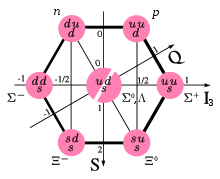- Λ-Baryon
-
Lambda-Baryon (Λ0)
Klassifikation Fermion
Hadron
BaryonEigenschaften [1] Ladung neutral
Masse
1115,683 ± 0,006 MeV/c2SpinParität 1/2+ Isospin 0 mittlere Lebensdauer (2,632 ± 0,020) · 10−10 s Quark-Zusammensetzung uds Das Λ-Baryon, auch Lambda-Baryon, ist ein Baryon das aus je einem Up-, einem Down- und einem Strange-Quark besteht. Es besitzt Spin 1/2 und Isospin 0. Das Lambda-Baryon ist elektrisch neutral und wird daher teilweise Λ0 bezeichnet.
Das Λ-Baryon gehört zur Klasse der Hyperonen.
Beschreibung
Das Λ0-Baryon gehört durch seinen Spin von 1/2 dem SU(3) Oktett an. Der Quarkinhalt der Δ-Baryonen lautet uds.
Das Λ-Baryon zerfällt zu beinahe 100% in ein Nukleon, also Proton oder Neutron, und ein Pion, wobei der Zerfall in ein Proton und ein π- mit 63,9 % fast doppelt so wahrscheinlich ist als der Zerfall in ein Neutron und ein π0 (35,8 %).[2]
Siehe auch
Einzelnachweise
- ↑ Die Angaben über die Teilcheneigenschaften (Infobox) sind, wenn nicht anders angegeben, entnommen aus: K. Nakamura et al. (Particle Data Group): Review of Particle Physics. In: Journal of Physics G 37 (2010) 075021 (online).
- ↑ N. Nakamura et al. (2010): Particle listings – Λ
Wikimedia Foundation.

